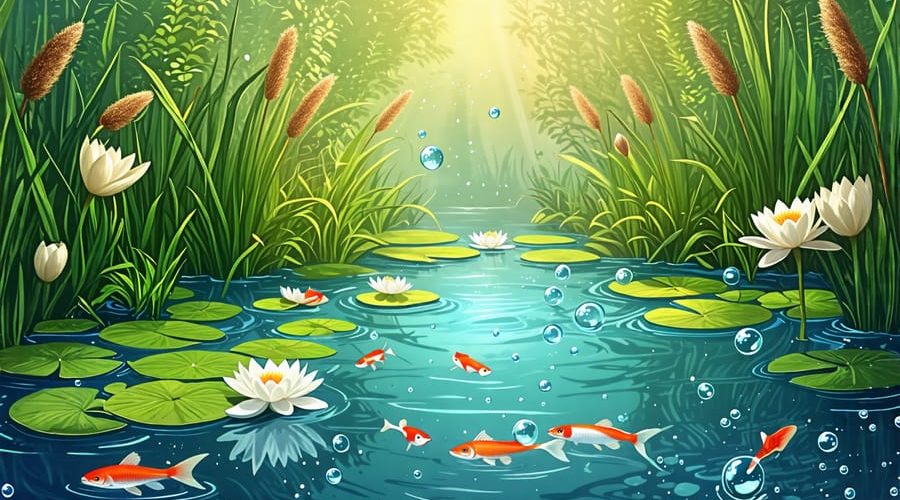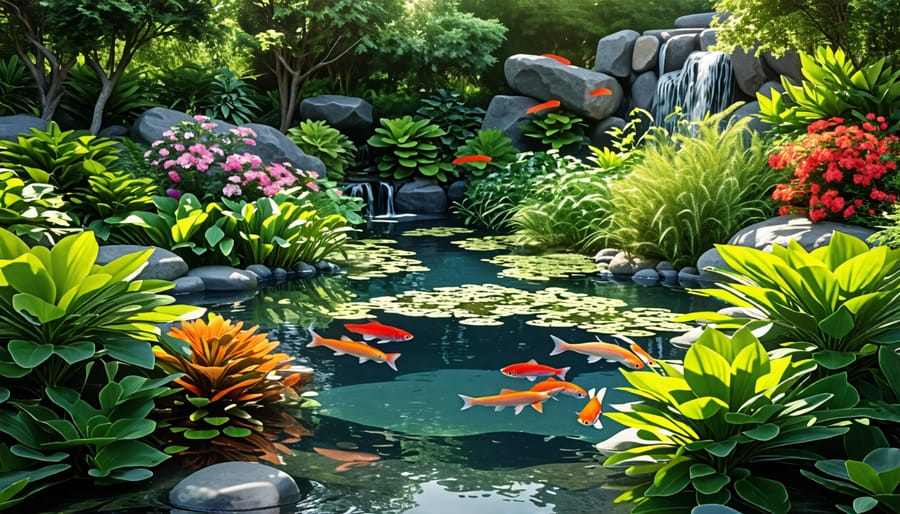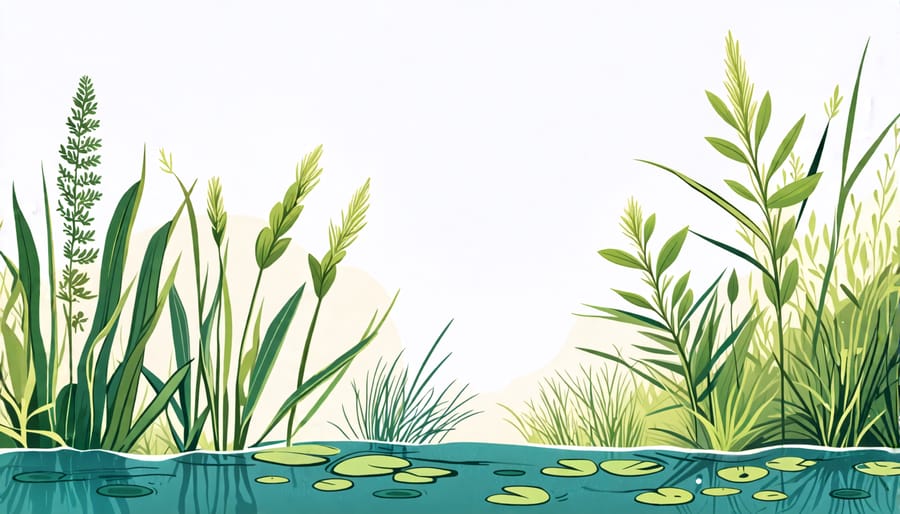
Revitalize Your Pond: Essential Tips for Responsible Aquatic Management
Transform your pond into a thriving ecosystem by implementing vital aquatic management techniques. Begin by strategically planting native aquatic vegetation to enhance water quality and provide habitat for wildlife. Regularly monitor and adjust water parameters such as pH and dissolved oxygen to maintain a balanced ecosystem. Introduce beneficial bacteria to naturally break down waste and prevent algae overgrowth, keeping your pond crystal clear. Implement sustainable water practices, such as using rainwater harvesting systems, to preserve resources while maintaining optimal water levels. Explore these strategies to harmonize beauty and ecology, nurturing a pond that flourishes with life.
Understanding Your Pond Ecosystem
The Balance of Flora and Fauna
Maintaining the balance between plant life and fish is crucial for a healthy pond environment. A harmonious relationship ensures that both flora and fauna flourish, creating a thriving plant and fish ecosystem. Plants provide essential oxygen that fish need to survive, while fish offer nutrients through their waste, which in turn promotes plant growth. It’s like a natural teamwork that keeps your pond vibrant and lively.
To achieve this balance, start by introducing a variety of plant species like submerged, floating, and marginal plants. These not only beautify your water garden but also help maintain water clarity and oxygen levels. Meanwhile, consider the type and number of fish; overcrowding can lead to a depleted environment. Regularly monitoring these elements allows you to tweak as needed, ensuring both the plants and fish complement each other’s needs.
Ultimately, a well-balanced pond not only looks stunning but also creates a sustainable ecosystem that requires minimal intervention. By fostering a balanced aquatic environment, you enhance the beauty of your outdoor space while being a responsible steward of nature.

Water Quality Indicators
When it comes to keeping your pond in top shape, understanding water quality indicators is key. Let’s dive into some critical markers! Firstly, pH levels, which measure the acidity or alkalinity of your water, should ideally sit between 6.5 and 8.5. This range supports a balanced aquatic environment where fish and plants thrive. Next up, check your pond’s oxygen levels. A well-aerated pond will usually have dissolved oxygen levels above 5 mg/L, perfect for promoting healthy aquatic life and preventing unpleasant odors. Keep an eye on ammonia levels too. High ammonia can be toxic to fish, so ensure they stay low by not overfeeding and maintaining proper filtration. Nitrate and nitrite levels are also critical. Both should ideally be under 0.5 mg/L to avoid harming your fish. Maintaining clear, debris-free water not only looks beautiful but promotes better health for your pond’s ecosystem. Regularly monitoring these indicators ensures your pond stays healthy and vibrant, providing a serene and stunning addition to your landscape.
Strategies for Sustainable Pond Management
Natural Filtration Techniques
Discovering natural filtration techniques can transform your pond into a naturally balanced ecosystem, friendly to both the environment and your backyard aesthetics. One captivating method involves the clever use of beneficial bacteria and plants, effectively nurturing a self-sustaining aquatic habitat. Beneficial bacteria, often available in pond stores, work wonders by breaking down harmful substances, such as ammonia and nitrites, into less harmful nitrates. These little helpers not only purify the water but also prevent algae blooms that can cloud your pond. Partner these bacteria with aquatic plants like water lilies or submerged grasses to maximize filtration. These plants act as natural sponges, absorbing excess nutrients that contribute to murky waters. By incorporating a natural pond filtration system, you’re ensuring clear water and a healthy environment for pond life. Embrace these eco-friendly techniques, and watch your pond thrive with sparkling clarity, bringing tranquility and beauty to your water garden.

Eco-friendly Maintenance Practices
Maintaining a pond in an eco-friendly way is easier than you might think! Start by reducing or eliminating chemical treatments. Instead, introduce native aquatic plants that naturally filter water and prevent algae bloom. Consider adding floating plants like water lilies, which not only improve water quality but also provide a beautiful landscape. To keep the ecosystem balanced, introduce beneficial bacteria. These microbes can be added in pellet form and help break down organic debris, maintaining clear water.
Regularly removing debris with a net is effective too. This simple step prevents the buildup of decaying matter, which can disrupt the pond’s health. Speaking from experience, I found that a gentle monthly cleaning routine using natural methods drastically reduced the need for harsh chemicals in my backyard pond. Encouraging biodiversity by introducing fish like minnows or native species that feed on algae can help maintain environmental balance while adding life and movement to your water garden. Remember, a few eco-friendly tweaks can lead to a thriving, sustainable pond!
Integrating Native Species
Choosing native plant and fish species for your pond can transform it into a vibrant, eco-friendly habitat. Native species are naturally adapted to the local environment, which means they require less maintenance and are more likely to thrive. They serve as a homegrown solution to creating a balanced ecosystem, as they tend to resist local pests and diseases better than exotic species. Additionally, native plants like water lilies and cattails provide essential shelter and breeding grounds for local wildlife, enhancing biodiversity.
The inclusion of native fish species also plays a pivotal role. Fish such as bluegill or largemouth bass are familiar to the pond’s natural surroundings, contributing to pest control by feeding on unwanted insects and maintaining the balance of your pond’s ecosystem. By fostering native plant life and fish, you’ll find your pond is not only more beautiful and harmonious but also a sustainable oasis that respects and nurtures local wildlife. Begin with an exploration of native species in your area, and watch as your pond becomes a thriving haven for nature’s wonders.
Tips for Troubleshooting Common Pond Issues
Algae Overgrowth Solutions
Algae overgrowth is a common challenge for pond enthusiasts, but with the right approach, you can transform your aquatic haven into a stunning centerpiece. The primary causes of algae bloom often include excess nutrients, such as phosphorus and nitrogen, usually from fertilizers or organic debris. Direct sunlight can also accelerate algae growth. To keep your garden pond crystal clear, start by reducing these excess nutrients. Regularly skim leaves and prune pond plants to prevent organic buildup. You might also consider installing a pond aerator or fountain to ensure adequate oxygen levels, which can help deter algae.
Another effective method is introducing beneficial bacteria to break down organic matter that feeds algae. Floating plants like water lilies can provide beneficial shade by blocking sunlight from the pond’s surface, naturally reducing algae presence. Remember, balance is key. During my first pond project, adding a mix of plant types and a few hardy fish not only controlled algae but also brought vibrant life and sounds to my backyard. With these steps, you’re well on your way to maintaining a healthy, visually appealing pond that enhances your outdoor space.
Dealing with Unwanted Pests
When it comes to managing a pond, unwanted pests can make waves in what should be a peaceful paradise. Common culprits like mosquito larvae, algae, and invasive snails might seem daunting, but fear not! There are humane ways to manage them, ensuring your pond thrives naturally. Mosquito larvae, for example, can be controlled by introducing mosquito fish or encouraging dragonflies to visit; these natural predators keep your pond buzzing with life, rather than bugs!
Algae, another frequent visitor, can be kept in check by maintaining a balance of plants and fish. Adding beneficial bacteria can also help reduce excess nutrients that algae feed on. If snails take over, consider adding native predators like certain fish species or ducks, which will keep the snail population down without harming your pond’s ecosystem.
Personal experience reveals that patience and observation are key. I fondly remember the time when simply planting more shade-giving lilies drastically reduced algae growth in my pond. Observing nature’s balance is both a joy and an essential part of sustainable pond management. Embrace these simple, friendly solutions, and your pond will be a harmonious haven in no time!
The Role of Seasonal Changes in Aquatic Management
Winterizing Your Pond
As the chill of winter approaches, it’s time to tuck your pond in for its long winter nap. Start by skimming out fallen leaves and debris, which can decompose and upset the water’s balance. Gradually reduce feeding your fish as the water temperature drops below 50°F; their metabolism slows down, and they don’t need much food. For plants, snip back dead foliage and consider moving sensitive ones indoors. Ensure your pump and filtration system are clean and running smoothly to maintain water quality. If your pond will freeze over, place a floating de-icer on the surface to keep a small area ice-free, ensuring gas exchange for aquatic life. By taking these steps, your pond will be ready to spring back to life once warmer weather returns.

Springtime Revival
As the sun starts to warm up your backyard oasis, it’s time to give your pond a springtime revival. Begin by skimming the surface for floating debris and removing any fallen leaves or twigs. This not only tidies up but also improves water quality by reducing decaying matter. Next, check your pond’s filter and pump system. Cleaning or replacing filters enhances water circulation, vital for healthy aquatic life. Consider adding plants like water lilies or irises; they provide shade and help balance oxygen levels, which fish and other pond dwellers appreciate. A personal tip: try introducing golden club to your pond – its vibrant blooms have been a favorite in my garden for years. Lastly, relax and enjoy watching your pond come alive, offering beauty and tranquility throughout the season.
Conclusion
As we conclude our exploration into effective pond management, it’s clear that creating a beautiful and sustainable water feature is within reach for everyone. By understanding the balance of ecology, from oxygenating plants to beneficial bacteria, you can transform your pond into a thriving habitat. Whether you’re a beginner or an experienced enthusiast, embracing eco-friendly practices not only enhances your pond’s beauty but also supports local wildlife. Let your pond be a testament to harmonious outdoor living and inspire others to follow suit. Dive in with enthusiasm and make every water gardening moment enjoyable and impactful!
